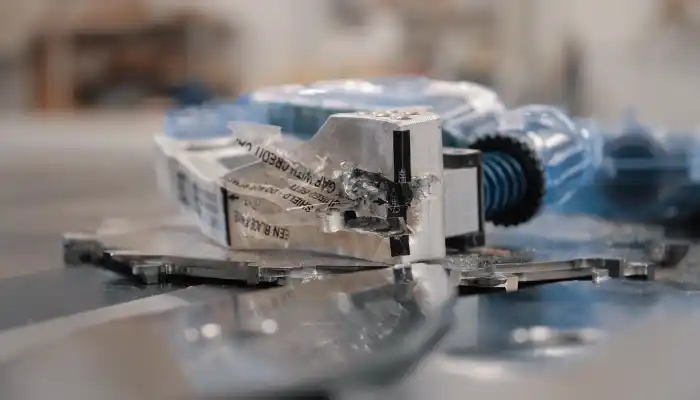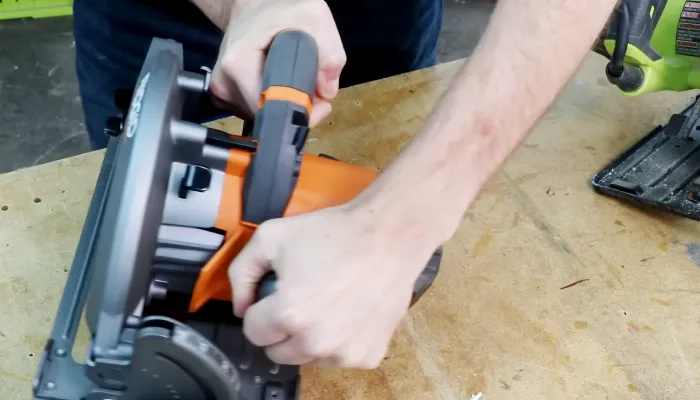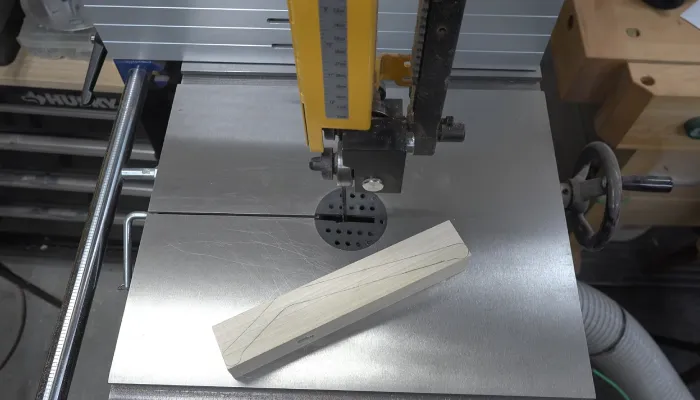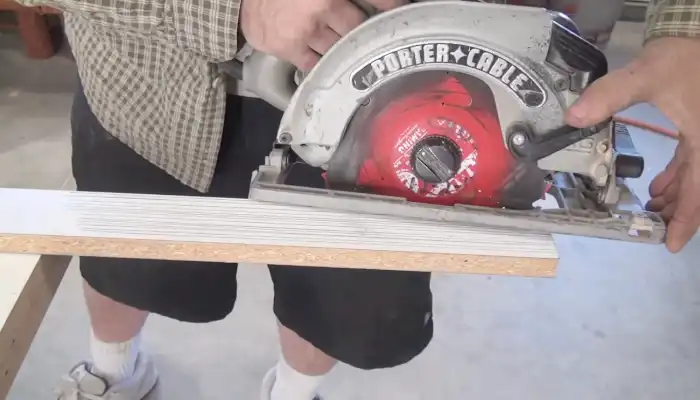Can You Burn Particle Board: Safer Alternatives
You shouldn’t burn particle board because it contains synthetic resins like formaldehyde that release toxic gases when burned. These include carcinogens, volatile organic compounds, and fine particulates. This poses serious health risks such as respiratory irritation and increased cancer risk.
Additionally, burning damages the environment by emitting persistent toxins and pollutants, violating air quality laws. Instead, proper disposal, recycling, or repurposing is recommended to avoid these hazards.
Understanding these risks and safer alternatives can help you handle particle board responsibly.
Key Takeaways
- Burning particle board releases toxic gases like formaldehyde, benzene, and dioxins, posing serious health and environmental risks.
- Particle board combustion emits harmful fine particles (PM2.5, PM10) that aggravate respiratory diseases and reduce air quality.
- Most regulations and environmental agencies strictly prohibit burning particle board due to its hazardous emissions and toxic ash residues.
- Proper disposal involves recycling, repurposing, or taking particle board to authorized facilities instead of burning it.
- Avoid burning particle board indoors or outdoors to prevent toxic fumes, legal penalties, and long-term environmental damage.
Composition and Chemicals in Particle Board
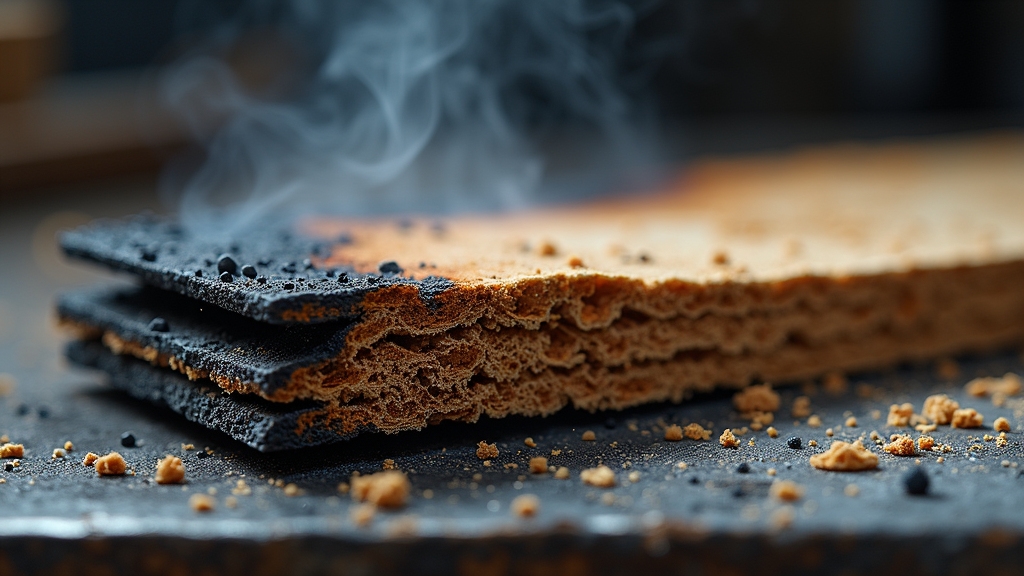
Although particle board might seem like a simple engineered wood product, its composition involves a precise blend of wood particles and synthetic resins that directly affect its performance.
You’ll find it made from wood chips, flakes, shavings, and sawdust, carefully dried and sized to optimize strength and surface smoothness. Fine particles coat the surface, while coarser ones form the core, balancing durability with a smooth finish. The manufacturing process also influences the cutting efficiency and finish quality of the boards.
Synthetic resins, primarily formaldehyde-based like urea-formaldehyde, bond these particles under heat and pressure. Resin application is controlled to ensure even coating, enhancing structural integrity and moisture resistance. It is typically bonded with non-water-resistant glue, which limits its use in exterior or high-humidity environments.
Variations include moisture-resistant resins and high-density boards with greater wood mass and resin content, designed for specific environments and uses. This precise composition governs particle board’s mechanical and physical properties.
Health Risks of Burning Particle Board
When you burn particle board, you release a complex mixture of toxic gases including formaldehyde, benzene, dioxins, and volatile organic compounds (VOCs).
All of these pose serious health hazards. These substances irritate your eyes, nose, and respiratory tract, causing headaches, coughing, and breathing difficulties. The release of formaldehyde is particularly concerning due to its recognized status as a carcinogenic compound.
These toxic substances cause eye, nose, and respiratory irritation, leading to headaches, coughing, and breathing difficulties.
The carbon monoxide emitted reduces oxygen delivery, increasing risks of heart attacks and worsening cardiovascular conditions.
Nitrogen oxides and fine particulate matter (PM2.5 and PM10) penetrate deep into your lungs, aggravating asthma, bronchitis, and other chronic respiratory diseases. The size and composition of these particles contribute significantly to their ability to infiltrate the respiratory system.
Sensitive populations, such as children, older adults, and those with pre-existing respiratory or cardiovascular issues, face heightened risks. These include immune suppression and long-term lung damage. Indoor burning considerably elevates pollutant levels, exacerbating health impacts in poorly ventilated spaces.
Particle pollution from wood burning can be a major outdoor source in some areas, adding to overall air quality concerns particle pollution. Avoid burning particle board to prevent these serious health consequences.
Environmental Effects of Burning Composite Wood
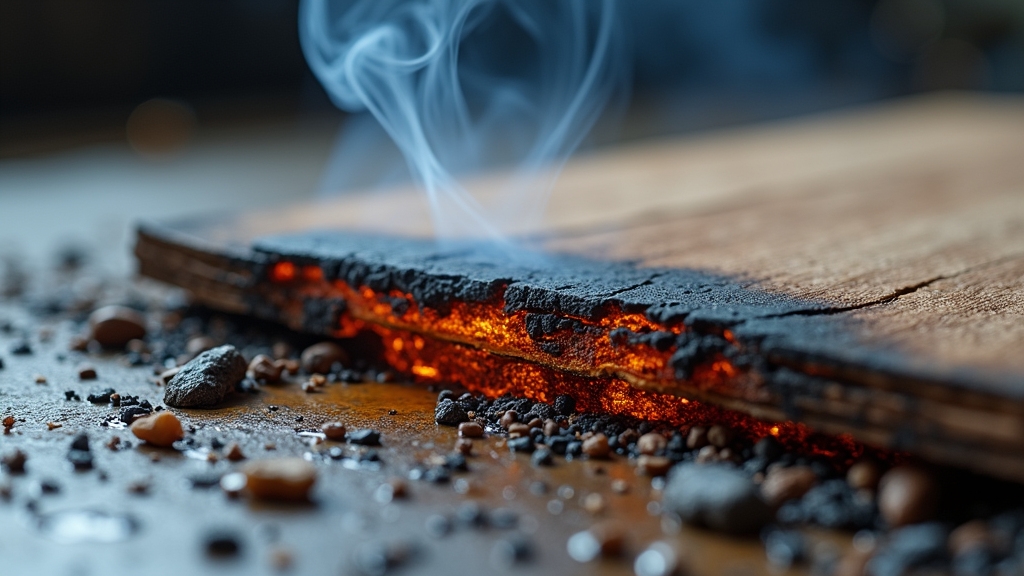
Because burning composite wood like particle board releases a variety of toxic pollutants, understanding its environmental effects is essential.
When you burn particle board, you release formaldehyde, benzene, and cyanide gases, along with particulate matter (PM2.5) and volatile organic compounds (VOCs). These pollutants degrade air quality and contribute to smog and ozone formation.
Additionally, combustion produces persistent toxins such as dioxins and PAHs, which can bioaccumulate in ecosystems. Some of these chemicals can chemically transform in the atmosphere, increasing their harmfulness through chemical changes.
The initial current surge of combustion can further exacerbate the release of these pollutants. Consider these critical environmental impacts:
- Air pollution spikes, with emissions sometimes exceeding those from vehicle traffic, impairing visibility and human health.
- Toxic ash residues contaminate soil and waterways, disrupting plant and aquatic life.
- Carbon dioxide and black carbon emissions accelerate climate change, increasing the carbon footprint compared to natural wood burning.
Official Guidelines on Burning Particle Board
Hey there! Just a heads up, burning particle board is a no-go in most places because it releases toxic emissions. Seriously, both state and federal regulations are pretty strict about this.
If you’re thinking about a cozy fire, it’s best to stick with untreated, dry wood. Make sure you’re using certified stoves too, as they help meet air quality and safety standards. Particle board and pressed board contain chemicals that are hazardous if ignited and should never be burned.
Ignoring these guidelines could lead to some serious health risks and even legal troubles. So, let’s keep it safe and stick to the rules!
Regulatory Restrictions Overview
Although particle board might seem like a convenient fuel source, regulatory restrictions strictly limit its combustion due to the toxic smoke and hazardous air pollutants it emits.
You’ll find that many state and local laws explicitly prohibit burning particle board to protect air quality and public health. Here’s what you should know:
- States like Iowa only allow burning natural wood or untreated landscape waste, explicitly banning composite wood products.
- Public events and fire safety codes forbid particle board burning because of formaldehyde and volatile organic compound emissions.
- Environmental agencies require permits for burning debris but exclude particle board, considering its toxic ash and pollutant release risks. These regulations reflect the complex structural modifications involved in managing hazardous materials safely.
Additionally, official open fire guidelines specifically prohibit burning particle board due to its potential to produce toxic materials and excessive airborne embers.
Ignoring these restrictions risks legal penalties and contributes to harmful air pollution. Always verify local regulations before attempting to burn particle board.
Government Burning Recommendations
Regulatory restrictions highlight the hazards of burning particle board. Official government guidelines provide specific recommendations to protect health and air quality. The use of materials like particle board in woodworking often involves adhesives and coatings that emit harmful compounds when burned, underscoring the importance of adhering to these regulations.
Agencies like the EPA and state environmental departments strictly prohibit burning particle board due to its toxic emissions, including formaldehyde and volatile organic compounds.
You must never burn particle board, plywood, treated, painted, or glued wood in fireplaces, stoves, or open fires. Many states enforce these rules through open burning regulations, with penalties for violations. Burning such materials can release criteria pollutants that contribute to air pollution and health risks.
Instead, burn only dry, untreated, and properly seasoned natural wood with moisture content below 20%. Using tools like the Grizzly G0623X table saw helps woodworkers prepare clean, untreated wood suitable for safe burning or other projects.
Additionally, upgrading to EPA-certified wood stoves and maintaining them regularly minimizes harmful emissions and complies with clean air laws. Following these guidelines helps you reduce toxic air pollution and safeguard respiratory health for yourself and your community.
Alternatives to Burning Particle Board

You know, recycling particle board can be a great way to give it a second life. One option is to break it down into wood fibers through specialized industrial processes. Recycling reduces environmental impact by minimizing hazardous waste and recovering valuable materials.
Proper preparation techniques, such as surface sanding, can enhance the quality of reclaimed wood fibers. Or, if you prefer, you can take it to authorized disposal facilities that are equipped to handle its chemical components safely.
Instead of burning the stuff, why not get creative? You could repurpose scrap material into some cool furniture or shelving. It’s a fantastic way to extend its lifecycle without releasing those toxic emissions into the air.
Recycling Options Available
How can particleboard waste be managed more sustainably instead of burning it? You can explore advanced recycling technologies and industrial processes that recover valuable materials while minimizing environmental impact.
Consider these options:
- Mechanical Sorting and Recycling: Use X-ray and optical sorting technologies to separate particleboard from contaminants, enabling high-purity wood chip recovery for reuse in new particleboard production. Proper preparation and cleaning of materials are essential to ensure high-quality recyclable inputs.
- Chemical Recycling: Apply chemical solutions to dissolve binders and extract clean wood fibers, improving material recovery efficiency and supporting reuse in manufacturing. Recent innovations such as ohmic heating have demonstrated promising results in hydrolyzing resin bonds in MDF, enhancing fiber recovery with lower energy use and water consumption ohmic heating technology.
- Incorporation of Recycled Content: Integrate recycled particleboard, pallet wood, and off-cuts into new boards, supported by advanced cleaning systems to remove metals and paints, reducing reliance on virgin wood. Precision in material alignment during processing helps maintain consistent quality in the resulting boards.
These techniques not only divert waste from incineration and landfills but also foster a circular economy in wood panel manufacturing.
Authorized Disposal Facilities
Authorized disposal facilities provide essential alternatives to burning particle board, ensuring compliance with environmental regulations and minimizing pollution risks. These facilities often follow strict guidelines to maintain environmental safety standards.
You should consider EPA-approved commercial disposal sites regulated under Title 40 CFR Part 761, especially for chemically treated particle board containing PCBs. Certified Construction & Demolition (C&D) sorting facilities, such as GreenWaste Florin Perkins, accept particle board for sorting and recovery, maximizing waste diversion.
Most jurisdictions in the RecycleSmart service area require a Waste Management Plan demonstrating at least 65% debris diversion. Proper management at these facilities helps prevent the release of toxic substances and supports sustainable resource use.
Additionally, specific landfills authorized by the California Regional Water Quality Control Board handle treated wood waste, including particle board with preservatives. Always confirm acceptance criteria beforehand.
Regional transfer stations like Sacramento Recycling & Transfer Station offer integrated debris management with regulated disposal processes. Using these authorized options helps you avoid environmental violations, fines, and uncontrolled contamination while ensuring particle board waste is managed safely and responsibly.
Safer Wood Waste Uses
Although burning particle board may seem convenient, exploring safer alternatives can substantially reduce environmental impact and health risks.
Instead of combustion, consider these practical options:
- Recycling into New Wood Products: Particle board can be processed into medium-density fiberboard (MDF) or engineered wood fibers. Up to 80% of wood waste can be reused efficiently through advanced sorting technologies. This recycling process significantly reduces landfill accumulation and environmental pollution.
- Biomass Energy Production: Wood waste serves as biomass fuel for electricity and heat generation. It emits fewer pollutants than fossil fuels and supports sustainable energy when used near biomass facilities.
- Composting and Soil Amendment: If free from toxic binders, chipped particle board enhances compost by regulating moisture and aeration. This creates nutrient-rich soil amendments while diverting waste from landfills.
Utilizing these alternatives minimizes hazardous emissions and promotes resource recovery. They’re technically and environmentally superior to burning particle board.
Fire Safety Concerns With Composite Wood
When dealing with composite wood like particle board, you must consider its inherent fire safety challenges due to its composition of small wood particles and resin-based adhesives.
These materials ignite more easily and burn faster than solid wood, especially if recycled or degraded particles are involved. Combustion releases toxic gases, increasing health risks. The type of adhesive used significantly affects the board’s flammability characteristics, with some resins being more combustible than others.
You should note that additives and laminates influence fire resistance, but untreated boards remain highly flammable and unsuitable for high-risk environments.
| Property | Characteristic |
|---|---|
| Ignition Time | 90–180 seconds (faster if recycled content) |
| Maximum Burning Rate | ~0.213 %·s⁻¹ (recycled particle boards) |
| Mass Loss During Burning | 44.9% to 51.7% |
| Autoignition Temp. | 425°F to 475°F |
Always prioritize fire-retardant treatments for safety.
Proper Disposal Methods for Particle Board
Since particle board contains resin binders that complicate recycling, you’ll need to explore specific disposal methods to manage it responsibly.
First, check with local recycling facilities to see if they accept clean, untreated particle board. They may break it down and combine it with new resin to create composites. Particle board is also known as chipboard, which can help when inquiring about recycling options.
When preparing particle board for disposal, be sure to handle it on a stable work surface to avoid damage or injury. Second, consider repurposing or donating usable pieces to organizations, schools, or makerspaces for non-structural projects, extending the material’s life.
Third, for damaged or bulk quantities, dispose of particle board at designated landfills or waste facilities, confirming local regulations and potential fees. Avoid composting due to chemical treatments.
Regulatory Restrictions and Legal Issues
Because particle board contains resins and adhesives that release toxic chemicals when burned, you must navigate strict regulatory restrictions before considering burning it.
In Virginia, open burning may require permits and mustn’t violate air pollution standards. Particle board often falls under prohibited materials due to its harmful emissions.
Local ordinances can impose even tighter rules, especially during smog season when burning such materials may be banned outright. The EPA advises against burning particle board, warning that it emits formaldehyde and VOCs, posing health and environmental risks.
Using particle board as fuel also voids EPA-certified stove warranties and can damage appliances. Violating these laws can lead to fines or legal action. Always check specific local and state regulations thoroughly before attempting to burn particle board.
Best Practices for Handling Particle Board Waste
Understanding the regulatory challenges around burning particle board highlights the importance of exploring safer and more effective waste management methods.
Since particle board contains chemical additives that release toxic fumes when burned, you should avoid open or indoor burning. Avoid burning particle board to prevent releasing harmful chemical fumes into the air.
Instead, consider these best practices:
- Proper Disposal: Contact local waste management for guidelines. Small amounts may be accepted in regular trash, while larger quantities often require landfill disposal or special handling if treated or painted. Fiberboard’s chemical adhesives prevent recycling and composting, making proper disposal essential.
- Repurposing and Upcycling: Extend particle board life by using intact panels for non-structural projects or donating usable pieces to community organizations.
- Safe Handling: Always wear N95 masks, gloves, and goggles when cutting or sanding to prevent inhalation of hazardous dust and chemical exposure.
Following these steps ensures safety and environmental responsibility.
Frequently Asked Questions
Can Burning Particle Board Affect Nearby Plants or Garden Soil?
Yes, burning particle board can harm nearby plants and garden soil.
You’ll expose plants to formaldehyde, VOCs, and dioxins, which damage leaves, reduce photosynthesis, and stunt growth.
Ash deposits introduce toxic chemicals and heavy metals into soil, harming microbes and lowering fertility.
These pollutants persist long-term, disrupting soil health and potentially entering the food chain.
Avoid burning particle board near gardens to protect your plants and soil ecosystems.
Does Particle Board Smoke Have a Distinct Smell Compared to Natural Wood?
Yes, particle board smoke has a distinct smell compared to natural wood.
You’ll notice a chemical or glue-like odor mixed with the wood scent, due to synthetic resins burning.
This acrid, pungent smell contrasts with the cleaner, earthy aroma of natural wood smoke.
The adhesive content intensifies the odor, especially if combustion is incomplete, making particle board smoke more unpleasant and noticeable than that from solid wood.
Can Small Amounts of Particle Board Be Safely Burned With Regular Firewood?
You might think a little particle board mixed with firewood won’t cause trouble, but it’s not worth the risk.
Even small amounts release formaldehyde and VOCs, which can harm your lungs and damage your stove’s components. Burning it can create stubborn soot and toxic fumes.
Stick to clean, untreated wood. For safety and efficiency, avoid particle board and opt for proper disposal or recycling instead.
Are There Any Homemade Methods to Neutralize Fumes From Burning Particle Board?
Yes, you can use homemade methods to neutralize fumes from burning particle board.
Place activated charcoal near the fire area to adsorb formaldehyde and VOCs effectively.
Sprinkle baking soda on surfaces or in small dishes nearby to neutralize odors and gases.
Also, increase ventilation and control humidity with fans or dehumidifiers to reduce fume concentration.
Combining these methods helps minimize harmful emissions practically and cost-effectively.
How Long Does It Take for Particle Board to Fully Burn in a Fire?
It typically takes several minutes to over 10 minutes for particle board to fully burn in a fire, depending on treatment and conditions.
Untreated particle board ignites rapidly, reaching peak burning rates within about 6 to 84 seconds after ignition.
Flame-retardant treatments can extend total burn time by roughly 15-40%, sometimes delaying peak heat release by up to 14 minutes.
Keep in mind, burning releases toxic gases, so caution is essential.
Toxic Fumes: The Hidden Threat Inside Particle Board
You shouldn’t burn particle board due to its toxic chemicals like formaldehyde, which release harmful fumes affecting your health and the environment.
For example, a local fire department once responded to a backyard burn where particle board smoke caused respiratory issues for nearby residents.
Instead, follow proper disposal methods like taking it to a recycling center or landfill that accepts composite wood. This approach guarantees safety, complies with regulations, and minimizes environmental harm.


